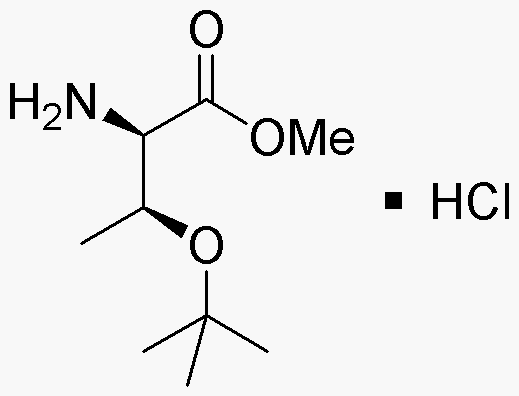O-tert-Butyl-D-threonine methyl ester hydrochloride is widely utilized in research focused on:
- Peptide Synthesis: This compound serves as a valuable building block in the synthesis of peptides, particularly in the pharmaceutical industry, where it helps create therapeutic agents.
- Chiral Auxiliary: It acts as a chiral auxiliary in asymmetric synthesis, aiding chemists in producing enantiomerically pure compounds, which are crucial for drug development.
- Biochemical Research: Researchers use it in studies of protein interactions and enzyme activity, providing insights into biological processes and potential drug targets.
- Drug Formulation: The compound is employed in formulating new drugs, enhancing solubility and stability, which can lead to more effective treatments.
- Analytical Chemistry: It is used in analytical methods to detect and quantify amino acids and related compounds, supporting quality control in various industries.
General Information
Properties
Safety and Regulations
Applications
O-tert-Butyl-D-threonine methyl ester hydrochloride is widely utilized in research focused on:
- Peptide Synthesis: This compound serves as a valuable building block in the synthesis of peptides, particularly in the pharmaceutical industry, where it helps create therapeutic agents.
- Chiral Auxiliary: It acts as a chiral auxiliary in asymmetric synthesis, aiding chemists in producing enantiomerically pure compounds, which are crucial for drug development.
- Biochemical Research: Researchers use it in studies of protein interactions and enzyme activity, providing insights into biological processes and potential drug targets.
- Drug Formulation: The compound is employed in formulating new drugs, enhancing solubility and stability, which can lead to more effective treatments.
- Analytical Chemistry: It is used in analytical methods to detect and quantify amino acids and related compounds, supporting quality control in various industries.
Documents
Safety Data Sheets (SDS)
The SDS provides comprehensive safety information on handling, storage, and disposal of the product.
Product Specification (PS)
The PS provides a comprehensive breakdown of the product’s properties, including chemical composition, physical state, purity, and storage requirements. It also details acceptable quality ranges and the product's intended applications.
Certificates of Analysis (COA)
Search for Certificates of Analysis (COA) by entering the products Lot Number. Lot and Batch Numbers can be found on a product’s label following the words ‘Lot’ or ‘Batch’.
Numéro de catalogue
Numéro de lot/série
Certificates Of Origin (COO)
This COO confirms the country where the product was manufactured, and also details the materials and components used in it and whether it is derived from natural, synthetic, or other specific sources. This certificate may be required for customs, trade, and regulatory compliance.
Numéro de catalogue
Numéro de lot/série
Safety Data Sheets (SDS)
The SDS provides comprehensive safety information on handling, storage, and disposal of the product.
DownloadProduct Specification (PS)
The PS provides a comprehensive breakdown of the product’s properties, including chemical composition, physical state, purity, and storage requirements. It also details acceptable quality ranges and the product's intended applications.
DownloadCertificates of Analysis (COA)
Search for Certificates of Analysis (COA) by entering the products Lot Number. Lot and Batch Numbers can be found on a product’s label following the words ‘Lot’ or ‘Batch’.
Numéro de catalogue
Numéro de lot/série
Certificates Of Origin (COO)
This COO confirms the country where the product was manufactured, and also details the materials and components used in it and whether it is derived from natural, synthetic, or other specific sources. This certificate may be required for customs, trade, and regulatory compliance.


